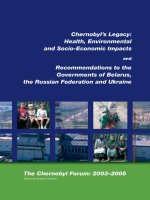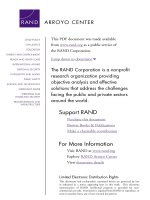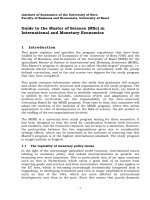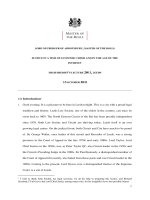Maternal polyunsaturated fatty acid status and offspring allergic disease up to the age of 18 months
Bạn đang xem bản rút gọn của tài liệu. Xem và tải ngay bản đầy đủ của tài liệu tại đây (1.23 MB, 71 trang )
MATERNAL POLYUNSATURATED FATTY ACID STATUS
AND OFFSPRING ALLERGIC DISEASES
UP TO THE AGE OF 18 MONTHS
YU YA-MEI
B.Sc. (Nutrition), SJTU
A THESIS SUBMITTED FOR THE DEGREE OF MASTER OF
SCIENCE
DEPARTMENT OF PAEDIATRICS
NATIONAL UNIVERSITY OF SINGAPORE
2014
DECLARATION
I hereby declare that this thesis is my original work and it has been written by
me in its entirety. I have duly acknowledged all the sources of information
which have been used in this thesis.
This thesis has also not been submitted for any degree in any university
previously.
YU Ya-Mei
12 May 2014
I
ACKNOWLEDGMENTS
The past one-plus year as a graduate student in NUS is really a wonderful
journeyfor me in terms of both academic training and personality maturity.I
would not have completed this journey without the help of countless people
over this period.
Most importantly, I am grateful for my supervisors to give me the opportunity
to be in GUSTO allergy and nutrition domain and I really have learned a lot
during this process. I learned to analyze the data, do regressions, design for
poster and write manuscripts, just to name a few. I thank Professor Hugo van
Bever for always giving critical comments on my presentations and results. I
thank Dr. Mary Chong for her patient teaching and encouragement. She
teaches me from basic skills, discuss with me for every result, review my
manuscript carefully, and always give me courage when I feel lost. I thank Dr.
Pan An for the precise guidance in analyzing, interpreting data and writing
manuscripts. I thank A/Prof LyneteShek to help form the hypothesis of my
research topic.
I am extremely grateful to GUSTO biostatistician Dr. Chan YiongHuak for his
guidance and advices in statistically analysis whenever I am in need.I thank
the research assistant Marjorelee T. Colega (SICS) for teaching me to do food
grouping for 1-day food recall data, and analyze 3-day food diary data.
A big thank you goes out to students in GUSTO who accompanied me and
gave me advices in research, especially Izzuddin b MohdAris, Antony
Hardjojo, and Chen Ling Wei.
I would like to acknowledge fellow investigators of the GUSTO study group,
clinic and home visit staff, and all the participants in the GUSTO study.
Without their participation, I would not have the data to do my analysis.
I appreciate a lot for NUS to give me the opportunity to be a graduate student in
Singapore. Singapore is a really nice place and people here are really nice and
agreeable. I will miss this place wherever I go in the future.
Finally, I thank the financial support by the Translational Clinical Research
(TCR) Flagship Program on Developmental Pathways to Metabolic Disease
funded by the National Research Foundation (NRF) and administered by the
National
Medical
Research
Council
(NMRC),
Singapore
(NMRC/TCR/004-NUS/2008).
II
TABLE OF CONTENTS
SUMMARY ...................................................................................................... V
LIST OF TABLES ......................................................................................... VII
LIST OF FIGURES ...................................................................................... VIII
LIST OF ABBREVIATIONS ..........................................................................IX
Chapter 1: Introduction and literature review .................................................... 1
1.1 Introduction .................................................................................................. 1
1.2 Atopy and allergic disorders ........................................................................ 2
1.2.1 Definitions................................................................................................. 2
1.2.1.1 Atopy, allergy and allergic diseases ....................................................... 2
1.2.1.2 Asthma and wheeze................................................................................ 4
1.2.1.3 Rhinitis ................................................................................................... 5
1.2.1.3 Eczema ................................................................................................... 7
1.2.2 The allergic march .................................................................................... 7
1.2.3 Fetal and early origin of allergic diseases ................................................. 9
1.3 Polyunsaturated fatty acid (PUFA) ............................................................ 10
1.3.1 Definition and nomenclature................................................................... 10
1.3.2 Categories and biosynthesis of PUFAs ................................................... 11
1.3.3 Requirements and changing in intakes for PUFAs ................................. 12
1.3.4 Biomarkers of PUFAs ............................................................................. 14
1.4 Mechanisms linking PUFA and allergy ..................................................... 15
1.4.1 Mechanisms of allergy ............................................................................ 15
1.4.2 n-6 fatty acids and allergic inflammation ............................................... 16
1.4.3 n-3 fatty acids and allergic inflammation ............................................... 18
1.5 Literature review ........................................................................................ 21
III
1.5.1 Cohorts of maternal PUFA status and offspring allergy ......................... 21
1.5.2 RCTs of maternal fish oil supplementation and offspring allergy .......... 24
1.6 Study hypothesis and aims of study ........................................................... 27
Chapter 2. METHODS..................................................................................... 28
2.1 Participants ................................................................................................. 28
2.2 Maternal plasma polyunsaturated fatty acid (PUFA) ................................. 28
2.3 Allergy outcome measurements ................................................................. 29
2.3.1 Allergy sensitization – skin prick testing (SPT)...................................... 29
2.3.2 Early childhood rhinitis, eczema and wheezing ..................................... 30
2.3.3 Allergic diseases ...................................................................................... 30
2.4 Statistical methods ..................................................................................... 31
Chapter 3. RESULTS ....................................................................................... 33
3.1 Maternal PUFA status and rates of allergy outcomes ................................ 33
3.1.1Maternal PUFA status .............................................................................. 33
3.1.2 Rates of allergy outcomes ....................................................................... 34
3.2 Population characteristics .......................................................................... 36
3.3 Association between maternal PUFA status and offspring allergy outcomes
.......................................................................................................................... 41
Chapter 4. DISCUSSION ................................................................................ 44
Chapter 5. CONCLUSION .............................................................................. 53
BIBLIOGRAPHY ............................................................................................ 54
IV
SUMMARY
Studies have suggested that maternal polyunsaturated fatty acid (PUFA) status
during pregnancy may influence early childhood allergic diseases, although
findings are inconsistent. We examined the relation between maternal PUFA
status and risk of allergic diseases in early childhood in an Asian study.
Maternal plasma samples (n=998) from the GUSTO mother-offspring cohort
were assayed at 26-28 weeks of gestation for relative abundance of PUFAs.
Offspring were followed up from 3 weeks to 18 months of age, and clinical
outcomes of potential allergic diseases (rhinitis, eczema, and wheezing) were
assessed by repeated questionnaires. Skin prick testing (SPT) was also
performed at age 18 months. An allergic disease was defined as having any one
of the clinical outcomes plus a positive SPT. The prevalences of a positive SPT,
rhinitis, eczema, wheezing and any allergic disease were 14.1% (103/728), 26.5%
(214/808),
17.6%
(147/833),
10.9%
(94/859),
and
9.4%
(62/657)
respectively.PUFAs of interest were first independently analyzed as continuous
variables to test for linear associations with various allergic outcomesi.e. SPT,
rhinitis, eczema, wheezing and any allergic disease with positive SPT in the
offspring using multiple linear regression models. To test for a possible
non-linear relationship and to examine dose-response, the PUFAs were next
categorized into quartiles within the total cohort, and binary logistic regression
models used for independent analyses of associations between individual
maternal PUFAs and the various allergic outcomes.After adjustment for
confounders, maternal total n-3, n-6 PUFA status and the n-6:n-3 PUFA ratio
were not significantly associated with offspring rhinitis, eczema, wheezing, a
positive SPT and having any allergic disease with positive SPT in the
V
offspring (P> 0.01 for all). A weak trend of higher maternal n-3 PUFA being
associated with higher risk of allergic diseases with positive SPT in offspring
was observed. These findings do not support the hypothesis that the risk of early
childhood allergic diseases is modified by variation in maternal n-3 and n-6
PUFA status during pregnancy in an Asian population.
VI
LIST OF TABLES
Table 1-1 Etiologic classification of rhinitis.
Table 1-2 Pro- and anti-inflammatory effects of PGE2 and LTB4.
Table 1-3 Summaries of studies of maternal fatty acid status and allergic
outcomes in infants and children.
Table 1-4 Summaries of studies of maternal fish oil supplementation during
pregnancy and allergic outcomes in infants and children.
Table 3-1 Fatty acid composition of maternal plasma PC measured at 26-28
weeks of gestation.
Table 3-2 Comparison of maternal characteristics of those with SPT data and
those without SPT data..
Table3-3 Maternal characteristics of the study participants and bivariate
associations with clinical allergic outcomes.
Table3-4 Infant characteristics and bivariate associations with clinical allergic
outcomes.
Table3-5 Comparison of maternal plasma PC PUFAs and family history of
allergic diseases across ethnicities.
Table 3-6 Infant allergy outcomes according to quartiles of maternal total
plasma PC n-3 PUFA, n-6 PUFA status and n-6:n-3 PUFA ratio.
Table 3-7 Infant allergy outcomes according to quartiles of maternal total
plasma PC n-3 PUFA, n-6 PUFA status and n-6:n-3 PUFA ratio in the group
without family history of allergic diseases.
Table 3-8. Association between maternal plasma PC PUFA status at 26-28
weeks of pregnancy and early childhood allergic diseases
Table 3-9. Association between maternal plasma PC PUFA status at 26-28
weeks of pregnancy and early childhood allergic diseases in the group with no
family history of allergic diseases
Table 3-10. Association between specific maternal plasma PC PUFAs at 26-28
weeks of pregnancy and early childhood allergic diseases
VII
LIST OF FIGURES
Figure 1-1 Allergy and allergic diseases.
Figure 1-2 Incidences of different types of allergic diseases by age.
Figure 1-3 The biosynthesis of n−6 and n−3 polyunsaturated fatty acids.
Figure 1-4 Generalized pathway for the conversion of arachidonic acid to
eicosanoids.
Figure 1-5 Generalized pathway for the conversion of eicosapentaenoic acid to
eicosanoids.
Figure 1-6 Biosynthesis of resolvins and protectins from DHA and EPA.
Figure 3-1: Flow chart of the participants in this study.
VIII
LIST OF ABBREVIATIONS
SFA
Saturated fatty acid
MUFA
Monounsaturated fatty acid
PUF
Polyunsaturated fatty acid
LA
Linoleic acid
EPA
Eicosapentaenoic acid
DHA
Docosahexaenoic acid
IMDR
Acceptable macronutrient distribution range
TSLP
Thymic stromal lymphopoietin
Th
T-helper
Ig
Immunoglobulin
IL
Interleukins
IFN
Interferon
TGF
Transforming growth factor
APC
Antigen-presenting cells
COX
Cyclooxygenase
HETE
Hydroxyeicosatetraenoic acid
HPETE
Hydroperoxyeicosatetraenoic acid
PG
Prostaglandin
TX
Thromboxane
DPA
Docosapentaenoic acid
RCT
Randomized controlled trial
IX
1
Chapter 1: Introduction and literature review
2
1.1 Introduction
3
Allergic diseases are one of the most common group of diseases worldwide,
4
resulting in a significant social and economic burden(1). In most children,
5
eczema is the earliest clinical manifestation of allergy, starting during the first
6
few months of life. Increasing evidence shows that infants who develop
7
allergy in early life have an altered immune response at birth(2, 3), suggesting
8
that allergic diseases may originate in utero. Thus, it is now postulated that
9
early life interventions during the antenatal period may confer protective
10
effects on the immune system(4).
11
12
Changes in modern lifestyle, including diet, have coincided with the escalating
13
rates of allergic diseases(5, 6). Amongst dietary factors, patters of intake of
14
polyunsaturated fatty acids (PUFAs)have received great interest. The
15
pro-inflammatory properties of n-6 PUFAs and anti-inflammatory properties
16
of n-3 PUFAs are well-established in both human and animal models(7-10).
17
For example, the n-6 PUFA arachidonic acid (AA; 20:4n-6) produces
18
eicosanoid mediators like prostaglandin (PG)E2, which promotes the
19
production of IgE, and leukotriene (LT)B4, which promotes airway
20
constriction(8). In contrast, the n-3 PUFAs eicosapentanoic acid (EPA;
21
20:5n-3) and docosahexaenoic acid (DHA; 22:6n-3) act to counter the effects
22
of AA(7). Consequently, increased intake of n-6 PUFAs and decreased
23
exposure to n-3 PUFAs in the antenatal period have been hypothesized to
24
increase the risk of offspring allergic diseases(11).
25
26
Fish and fish oil are sources of EPA and DHA. Fish oil supplementation
27
studies in pregnant women(12-14) and observational studies on fish intake
28
during pregnancy(15, 16) have suggested protective effects on offspring
29
allergy. However, studies reporting the relationship between maternal plasma
30
PUFA status and childhood allergic diseases have yielded inconsistent results.
31
The Southampton Women’s Survey (SWS) study found a weak protective
32
effect of maternal EPA, DHA and total n-3 PUFAs against non-atopic
1
33
persistent/late wheezing in offspring aged 6 years(17). The KOALA Birth
34
Cohort found AA and the ratio of n-6 to n-3 PUFAs to be protective against
35
childhood eczema(18). No significant associations were found in the Avon
36
Longitudinal Study of Parents and Children (ALSPAC) cohort(19) or in
37
another small study(20). Thus, whether higher n-3 PUFA status during
38
pregnancy would lower the risk of childhood allergic diseases remains unclear.
39
40
In the previous publications(17-20), most allergic outcome measurements
41
were performed in Caucasian children aged 4-7 years. No study has been done
42
in an Asian population to investigate allergic diseases at a younger age. In this
43
study, we investigated the relationship between maternal PUFA status and
44
potential allergic diseases up to the age of 18 months in an Asian multi-ethnic
45
birth cohort.
46
47
1.2 Atopy and allergic disorders
48
1.2.1 Definitions
49
1.2.1.1 Atopy, allergy and allergic diseases
50
The nomenclature proposed in the October 2003 report of theNomenclature
51
Review Committee of the World Allergy Organization defined atopy as a
52
“personal and/or familial tendency, usually in childhood or adolescence, to
53
become sensitized and produce IgE antibodies in response to ordinary
54
exposures to allergens, usually proteins”(21).As a consequence, atopy is a
55
tendency for exaggerated IgE responses. The term atopycannot be used until an
56
IgE sensitization has been documented by IgE antibodies in serum or by a
57
positive skin prick test (SPT)(21).
58
59
Allergy is defined as a “hypersensitivity reaction initiated by specific
60
immunologic mechanisms”(21).Allergy refers to the clinical expression of
2
61
allergic diseases, including asthma, rhinitis, eczema and food allergy.
62
63
Allergic diseases are manifest as hyper-responsiveness in the target organ,
64
whether skin (eczema), nose (rhinitis), lung (asthma), or gastrointestinal tract
65
(food allergy). (Figure 1-1)
66
67
68
Figure 1-1Allergy and allergic diseases(22)
69
What makes allergy complicated is that only a proportion of atopic subjects
70
(with a positive SPT result) have clinical symptoms (asthma, rhinitis, eczema);
71
and those with clinical symptoms may not have a positive SPT result.Clinical
72
symptoms are classified as non-allergic when total IgE is normal and/or specific
73
IgE to common allergens is not detected in the serum or on skin-prick test. For
74
example, in a whole-population birth cohort, it was reported that 30% to 40% of
75
cases of the clinical symptoms in 4 year old children are attributableto atopy and
76
60% to 70% of cases could be accounted forby organ-based and other
77
factors(23).
78
79
In addition to systematic allergy (a positive skin prick test), recent researches
80
are exploring the potential importance of local inflammation and IgEproduction
3
81
in the mucosal tissue of the end organs. It was reported that in persistent
82
non-allergic rhinitis, some patients may have local inflammation, nasal IgE
83
production, and a positive response to a nasal allergen provocation test despite
84
no evidence of systemic atopy(24). Furthermore, local allergic rhinitis (LAR) as
85
a condition involving a localized nasal allergic response in the absence of
86
systemic atopy has been identified(25, 26).As a consequence, although a
87
genetic tendency of atopy may underlie all the allergic diseases, there could also
88
be organ specific predispositions for the allergic symptoms (i.e. lower airways
89
for asthma, nose for rhinitis and skin for eczema). In this case, different allergic
90
diseasesmay deserve separate consideration, which will be elaborated in the
91
following chapters.
92
93
1.2.1.2 Asthma and wheeze
94
Asthma is one of the most common chronic diseases of childhood, and is
95
defined as a chronic inflammatory disease of the lower airways, leading to
96
symptoms of recurrent wheezing and cough(27).Asthma has infancy origins
97
and longitudinal studies found that of those children with asthma at age 7 years,
98
about 40% have started wheezing during the first two years of life(28).
99
100
Wheezing is a high pitched, whistling sound that occur when smaller airways
101
are narrowed by presence of bronchospasm, swelling of mucosal lining,
102
excessive amounts of secretions, or inhaled foreign body. It is heard mostly on
103
expiration as a result of critical airway obstruction(29).The Tucson Children’s
104
Respiratory Study, a prospective birth cohort studies starting in 1980, proposed
105
three different patterns of recurrent wheezing in pediatric patients(30): transient
4
106
early wheezing, non-allergic wheezing, and allergic wheezing (31). Transient
107
infant wheezing is relatively benign and most children would stop wheezing
108
after the age of 3 years. Non-allergic wheezing is mainly triggered by viral
109
infection and tends to remit later in childhood. Allergic wheezing is linked to
110
IgE-mediated sensitization. It includes early atopic wheezingand late atopic
111
wheezing.Early atopic wheezingtakes the most part ofwhat we have called in
112
the past ‘persistent wheezing’. Late atopic wheezingis what we called in the
113
past‘late-onset wheezing’, and the patients only started wheezing at 6 years of
114
life.
115
116
1.2.1.3 Rhinitis
117
Rhinitis is an inflammation of the upper airways that is characterized by
118
symptoms of runny (rhinorrhea) and/or blocked nose and/or sneezing occurring
119
for two or more consecutive days and lasting for more than an hour for most
120
days (32, 33).Diary recording of symptoms and their circumstances over a
121
2-week period may be helpful in borderline cases. Though not viewed as life
122
threatening, rhinitis impairs quality of life, sleep, work (34) and school
123
performance(35), and have the long-term risk ofincreasing the development of
124
asthma (36).
125
126
From an etiologic point of view, noninfectious rhinitis has been traditionally
127
classified as allergic rhinitis (AR) and nonallergic rhinitis (NAR) based on the
128
presence and absence of allergic sensitization(32).However, this approach has
129
recently been suggestedto be incomplete because patients previously given a
130
diagnosis of NAR might actually be classified as having Local allergic rhinitis
5
131
(LAR) because they have nasal symptoms after Nasal allergen provocation test
132
(NAPT) with a common aeroallergen (24, 37), and local production of sIgE was
133
detected in these patients. LAR is a localized nasal allergic response in the
134
absence of systemic atopy characterized by local production of specific IgE
135
(sIgE) antibodies, a TH2 pattern of mucosal cell infiltration during natural
136
exposure to aeroallergens, and a positive nasal allergen provocation test
137
response with release of inflammatory mediators (tryptase and eosinophil
138
cationic protein) (25).As a result, a new etiological classification of rhinitis has
139
been proposed (Table 1-1)(25, 38).However, it remains a matter of debate
140
whether local sensitization would be the primary event in any AR disease and
141
can develop into systemic classical AR in the future (25). This requires
142
appropriate prospective studies.
143
Table1-1 Etiologic classification of rhinitis.
1. Allergic rhinitis
Allergic rhinitis (with systemic atopy)
i. Classical classification
1. Time of exposure to aeroallergen or aeroallergens: perennial, seasonal, and
occupational
ii. ARIA classification(32)
1. Duration of symptoms: persistent and intermittent
2. Severity of symptoms: mild, moderate, and severe
Local allergic rhinitis (without systemic atopy)
i. Classical classification
1. Time of exposure to aeroallergen or aeroallergens: perennial, seasonal, and
occupational
ii. ARIA classification(32)
1. Duration of symptoms: persistent and intermittent
2. Severity of symptoms: mild, moderate, and severe
2. Nonallergic rhinitis
Infectious
Occupational (irritant)
Drug induced
Hormonal
Irritant
Food
Emotional
Atrophic
NARES
Idiopathic
144
145
Adapted from Rondon et al. (38)
6
146
1.2.1.3 Eczema
147
Eczema is a chronic inflammatory pruritic skin disease that affects a large
148
number of children and adults in industrialized countries (39). It often begins in
149
early infancy and follows a course of remissions and exacerbations(40), thus is
150
considered to be one of the first manifestations in the atopic march. 50% of
151
those with eczema during the first 2 years of life will develop asthma
152
subsequently (41). The severity of eczema, including early sensitization to food,
153
increases the risk of asthma and allergic rhinitis(40, 42).Infants typically
154
present with erythematous papules and vesicles on the cheeks, forehead, or
155
scalp, which are intensely pruritic(39).Scoring Atopic Dermatitis (SCORAD)
156
(43) has been used to classify AD into 3 main severity forms: mild (<15),
157
moderate (>15 and <40) and severe (>40).
158
159
Eczema has been subtyped as allergic (formerly extrinsic) and nonallergic
160
(formerly intrinsic), representing approximately 80% and 20% of adult patients,
161
respectively (44).The term topic eczema is used when the underlying
162
inflammation is dominated by an IgE-antibody associated reaction, determined
163
based on an IgE-antibody determination or skin test. Otherwise it should be
164
termed non-atopic eczema(21).
165
166
1.2.2 The allergic march
167
A pattern of progression through different allergic disorders in early childhood
168
has been termed the ‘allergic march’, with eczema and food allergy dominating
169
in early childhood, while asthma and rhinitis are more common later (45).
170
(Figure 1-2)
7
171
172
173
174
Figure1-2 Incidences of different types of allergic diseases by age.(22)
175
Evidence for the allergic march from eczema to allergic rhinitis and asthma are
176
raised from longitudinal studies. Rhodes et al. (46, 47)followed 100 infants with
177
at least one allergic parentup to 22years in the United Kingdom. The prevalence
178
of eczema peaked at 1 year of agein 20% of children,but later declined to
179
approximately 5% at 22 years of age. However, the prevalence of allergic
180
rhinitis slowly increased over time, from 3% to 15%. The prevalence of parents
181
reporting wheezing increased from 5% at the age of 1 year to 40% at 22 years of
182
age. Moreover, sensitization to allergen tested by skin prick test increased over
183
time to a peak of 36% at 22 years of life. The Tucson Children’s Respiratory
184
Study found that eczema during the first 2 years of life was an independent risk
185
factor for persistent wheezing up to 6 years of life, and was associated with
186
inactive and chronic asthma but not with newly diagnosed asthma at 22 years
187
old(30, 48).
188
189
The putative mechanism of the allergic march is that the allergen exposure
190
through the epidermis can initiate systemic allergy and predispose individuals
8
191
to allergic rhinitis, and asthma in the airways(45, 49). Epithelial barrier defects
192
derived from loss-of-function mutations in the filaggrin gene have been
193
identified as a strong predisposing factor for eczema and secondarily, to the
194
development of asthma(50). Thymic stromal lymphopoietin (TSLP),
195
apro-inflammatory factor derived from epithelial cells have also elicited
196
considerable interest, asit has been shown to stimulate mast cells to produce
197
TH2 cytokines(51).
198
199
1.2.3 Fetal and early origin of allergic diseases
200
The “development origins of health and disease” paradigm maintains that
201
nutritional or other environmental stimuli during critical periods of growth and
202
development have the potential to permanently “program” the structure and/or
203
function of cell populations, emerging organ systems, or homeostatic pathways
204
(52). Since Barker’s findings that exposures in utero could have lifelong
205
influenceon cardiovascular diseases and othertraits (53), there has been
206
considerable interest in the role of early life events plays in health and diseases.
207
208
Early life origins of asthma have been recognized in birth cohort
209
studies.Children who have a diagnosis of asthma have often started wheezing
210
during infancy. Indeed early age of onset is a recognized risk factor for
211
persistence of asthma(48, 54). The ALSPAC study which includes 6265
212
children found thatof the children who have asthma at 7 years of age, about 40%
213
have started wheezing during the first two years of life(28).Other longitudinal
214
birth cohortshave shown strong association between lung function(55) and
215
airway responsiveness(56) measured soon after birth and asthma later in
9
216
childhood. Furthermore, cohorts followed from childhood to adult life (57)have
217
demonstrated that lung function changes associated with asthma become
218
established in early childhood and then track to adulthood. Theseresultslead to
219
the hypothesis that pulmonary developmental changes associated with asthma
220
in childhood and even adulthood are already established at birth or shortlyafter
221
that (3).On the other hand, fetal exposure to environmental factors such as
222
maternal smoking, diet have been reported to be linked to the development of
223
the fetal immune system(58),decreased lung function(59), and risk of
224
developing asthma and wheezing in the offspring(60, 61). These evidences
225
strengthen the hypothesis the fetus is not immunologically naive and
226
intrauterine exposures can act directly to invoke immunological sensitization
227
leading to postnatal airway inflammation.
228
229
1.3 Polyunsaturated fatty acid (PUFA)
230
1.3.1 Definition and nomenclature
231
There are three kinds of fatty acid: saturated (SFA), monounsaturated (MUFA,
232
possessing one carbon-carbon double bond), or polyunsaturated (PUFA,
233
possessing two or more carbon-carbon double bond).
234
235
The standard numbering system for fatty acids gives the number of carbon
236
atoms, the number of double bonds (after a colon), and the position of the first
237
double bond (after the letter n) counting from the end of the carbon chain
238
opposite the carboxyl group. For example, linoleic acid (LA) is denominated as
239
18:2n-6, because it has a total of 18 carbon atoms in the chain, with 2 double
240
bonds, and the first double bond is on the 6th carbon position from the methyl. In
10
241
addition, fatty acids are often expressed by their abbreviations. The fatty acids
242
relevant to the current thesis are listed as follows:
243
Linoleic acid (LA; 18:2n−6)
244
Arachidonic acid (AA; 20:4n−6)
245
α-Linolenic acid (ALA; 18:3n−3)
246
Eicosapentaenoic acid (EPA; 20:5n−3)
247
Docosahexaenoic acid (DHA; 22:6n−3)
248
249
1.3.2 Categories and biosynthesis of PUFAs
250
The number, position,and configuration of the double bonds of PUFAs also
251
largely determine their physicaland biologic properties. Biologically relevant
252
families of PUFAs are the n–6 and the n–3 fatty acids. In the n-6 PUFA family,
253
LA is the simplest member and as the precursor of n-6 family PUFAs, it is
254
capable of being metabolized to longer-chain, more unsaturated n-6 PUFAs. LA
255
is first converted to γ-linolenic acid (18:3 n–6) by Δ6-desaturase, and
256
thenγ-linolenic acid can be elongated (by elongase) to dihomo-γ-linolenic acid
257
(20:3
258
Δ5-desaturase, yielding AA. Similarly, ALA is the simplest members of n-3
259
family PUFAs and can be synthesized to a sequence of longer chain n-3 fatty
260
acids, including EPA and DHA. (Figure 1-3) During this process, n-3 and n-6
261
PUFAs are competing for the same set of enzymes, such as δ-6 desaturase.
262
Although supplemental ALA raises EPA and DPA status in the blood, ALA or
263
EPA dietary supplements have little effect on blood DHA levels(62). This
264
result demonstrates that the rate of conversion from ALA to DHA is very low
265
in human.
n–6).
Dihomo-γ-linolenic
acid
11
canbe
desaturated
further
by
266
267
268
269
270
271
272
273
Figure 1-3The biosynthesis of n−6 and n−3 polyunsaturated fatty acids. LA
and ALA can be synthesized to more unsaturated PUFAs, during which
process they are competing for the same set of enzymes.EPA and DHA, the
most biologically relevant n–3 fattyacids, are highlighted in red.(63)
1.3.3 Requirements and changing in intakes for PUFAs
274
LA and ALA cannot be synthesized in mammals and human, as mammals lack
275
enzymes to insert thedouble bond in the n–6 or n–3 position.Therefore they are
276
defined as essential fatty acids to human. The lack of LA and ALA, as well as
277
some of their elongatedand more unsaturated products, leads to a syndrome of
278
deficiency (64, 65).This syndrome of deficiency is usually characterized by
279
desquamativerashes and hyperkeratoticdermatoses
280
estimates of the minimum requirementsfor n–6 and n–3 fatty acids in adults are
281
1.0% and 0.2% of daily energy intake,respectively. (66)An expert consultation
282
of
283
non-pregnant/non-lactating adult females the acceptable macronutrient
284
distribution range (IMDR) of DHA plus EPA should be0.25 to 2.0 g per day.
285
For adult pregnant and lactating females, the minimum intake for optimal
286
adult health and fetal and infant development is 0.3 g/d EPA+DHA, of which
FAO
and
WHO
recommended
12
that
for
in humans. Current
adult
males
and
287
at least 0.2 g/d should be DHA. There is insufficient evidence to set a specific
288
minimum intake of either EPA or DHA alone; both should be consumed(66).
289
290
LA is found in significant quantities in many vegetable oils, including corn,
291
sunflower, and soybean oils, and in products made from such oils, such as
292
margarines. AA is found in meat and offal and intakes are estimated at 50 to 500
293
mg/day. EPA, DPA, and DHA are found in fish, especially so-called “oily” fish
294
(tuna, salmon, mackerel, herring, and sardine). One oily fish meal can provide
295
between 1.5 and 3.5 g of these long-chain n−3 PUFAs. Fish oils supplements
296
available in the commercial market contain 30% long-chain n−3 PUFAs of the
297
fatty acids in the capsule. Thus, consumption of a typical 1-g fish oil capsule per
298
day can provide about 300 mg of these fatty acids. In the absence of oily fish or
299
fish oil consumption, intake of long-chain n−3 PUFAs is likely to be <100
300
mg/day, although foods fortified with these fatty acids are now available in
301
many countries (15). In the United States, intake of n-3 fatty acids EPA and
302
DHA is only 0.1–0.2 g/d (67), which is below the recommendation of 0.2g/d
303
byFAO and WHO(66).
304
305
In 20th century, the amount of linoleic acidin western diet has increased
306
remarkably, with the change being most marked since the early 1960s. The
307
availability of linoleic acid (LA) increased from 2.79% to 7.21% of energy from
308
1909 to 1999 in the United States(68). These changes are in large part due to a
309
significant increase in the use of margarine and vegetable oils, which contain
310
large amount of LA. Although from 1909 to 1999, the availability of n-3 PUFA
311
ALA increased 85% from 0.39% of energy to 0.72% of energy, there were no
13
312
remarkable changes in the availability of long-chain n-3 PUFAs EPA, DPA and
313
DHA (68). As a result, the ratio of n-6 to n-3 fatty acids is around 9.8:1 at the
314
end of 20th century (67). This biased intake that favors n-6 PUFAs intake has
315
been linked to the increased prevalence of a variety of diseases such as
316
cardiovascular diseases (63)and allergic diseases(69).
317
318
1.3.4 Biomarkers of PUFAs
319
Accurate assessment of PUFA intake is essential to examine the associations
320
between PUFAs in diet and disease risk in epidemiological research. However,
321
relative intakes of individual PUFAs in the diet are difficult to estimate
322
accurately from dietary assessment methods such as food frequency
323
questionnaires food recall and food diary. This is in part because that
324
respondents often under-report consumption, especially in obese population
325
(70). Moreover, respondents would consciously or sub-consciously alter their
326
usual diet, during the recording period. Interviewer bias and respondent burden
327
also add to the imprecise measurement. Instead, using plasma fatty acids
328
concentrations as a biomarker for dietary intake can complement the drawbacks
329
dietary assessment methods, and have the potential to be used more
330
quantitatively (71). It seems reasonable to expect that the best markers of
331
dietary intake exist for the fatty acids that cannot be endogenously synthesized.
332
These include the n-3 PUFAs (ALA from plant sources and long-chain n-3 fatty
333
acids from marine sources), the n-6 polyunsaturated fatty acids (mostly from
334
vegetable oils).
335
336
Adipose tissue, plasma lipid fractions (such as plasma total phospholipids and
14
337
phosphorylcholine), and erythrocyte total phospholipids are the three types of
338
human sample that are often used as biomarkers of PUFAs. The fatty acid
339
composition of adipose tissue has been considered a gold standard for the
340
representation of dietary fatty acids, due to the slow turnover time in weight
341
stable individuals. The t1/2 of adipose tissue lipids were estimated to be between
342
6 and 9 months using stable isotope methodology (72). Significant positive
343
correlations between the relative intake of dietary PUFA and the relative content
344
of adipose tissue n-6 and /or n-3 or total PUFA have been noted (71). Plasma
345
lipid fractions can reflect only recent, that is the preceding few weeks, rather
346
than long-term intake. Within days after altered composition of dietary fatty
347
acids, the fatty acid composition of plasma lipid fractions change accordingly
348
(73). Traditionally, fatty acids measured in erythrocytes were thought to
349
represent fatty acid intake for several months, because erythrocytes have a life
350
span of approximately 120 days. However, it has been reported that the fatty
351
acid composition of erythrocyte PL reflects changes in dietary fatty acid intake
352
within 24 h with an increase of LA (73) and this could only be explained by the
353
exchange and transfer of fatty acids from plasma to erythrocytes. In this case,
354
fatty acids measured in erythrocytes are representing a period of fatty acid
355
intake as short as that in plasma lipid fractions.
356
357
1.4 Mechanisms linking PUFA and allergy
358
1.4.1 Mechanisms of allergy
359
The immunological mechanism associated with allergy is the biased expression
360
of T-lymphocyte and cell-mediated responses to common allergens towards
361
T-helper-2 (Th-2) lymphocyte activity. Th-2 lymphocytes give rise to peptide
15









